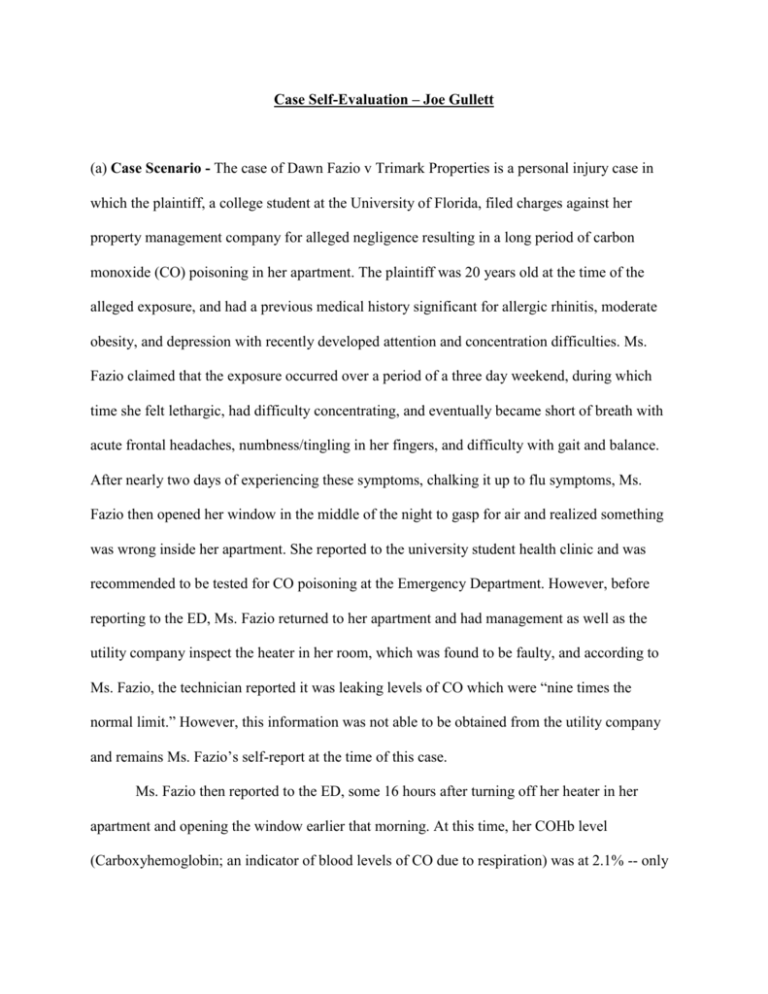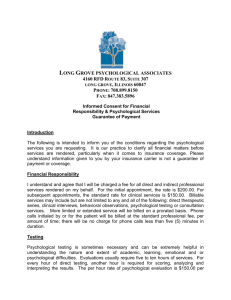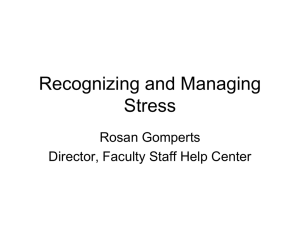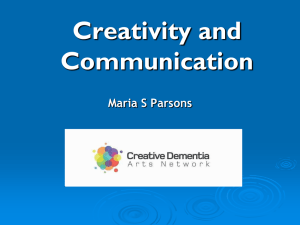Gullett_Case Eval Assignement_reflection
advertisement

Case Self-Evaluation – Joe Gullett (a) Case Scenario - The case of Dawn Fazio v Trimark Properties is a personal injury case in which the plaintiff, a college student at the University of Florida, filed charges against her property management company for alleged negligence resulting in a long period of carbon monoxide (CO) poisoning in her apartment. The plaintiff was 20 years old at the time of the alleged exposure, and had a previous medical history significant for allergic rhinitis, moderate obesity, and depression with recently developed attention and concentration difficulties. Ms. Fazio claimed that the exposure occurred over a period of a three day weekend, during which time she felt lethargic, had difficulty concentrating, and eventually became short of breath with acute frontal headaches, numbness/tingling in her fingers, and difficulty with gait and balance. After nearly two days of experiencing these symptoms, chalking it up to flu symptoms, Ms. Fazio then opened her window in the middle of the night to gasp for air and realized something was wrong inside her apartment. She reported to the university student health clinic and was recommended to be tested for CO poisoning at the Emergency Department. However, before reporting to the ED, Ms. Fazio returned to her apartment and had management as well as the utility company inspect the heater in her room, which was found to be faulty, and according to Ms. Fazio, the technician reported it was leaking levels of CO which were “nine times the normal limit.” However, this information was not able to be obtained from the utility company and remains Ms. Fazio’s self-report at the time of this case. Ms. Fazio then reported to the ED, some 16 hours after turning off her heater in her apartment and opening the window earlier that morning. At this time, her COHb level (Carboxyhemoglobin; an indicator of blood levels of CO due to respiration) was at 2.1% -- only 0.1% above the liberal cutoff for suspected CO exposure in non-smoking populations. There are several different organizations which impose much more conservative estimates of COHb levels, such as OSHA, which stipulates that they be above 3.0% in non-smokers to suggest significant exposure. Additionally, although Ms. Fazio was not asked whether she was a smoker at the time of exposure according to medical records from her visit to the ED, a later medical record indicated that it was questionable whether or not she had been using tobacco at the time of exposure as she stated that she had “recently quit” at an infirmary visit 1 month after her exposure. This brings into question the significance of her on-the-cusp COHb level. However, the temporal lag between exposure and the length of exposure (>2 days) suggests, based on the half-life elimination time of COHb in human blood serum, that Ms. Fazio may have in fact experienced a significant level of exposure. During the months following her exposure, Ms. Fazio’s physical symptoms were reported to health care professionals to have been getting better. Subsequent to her visit to the ED acutely, she was no longer experiencing tingling, numbness, gait difficulty, and shortness of breath. She did not report continued difficulties with concentration and attention, however these problems were present to a mild degree prior to her exposure according to Dr. Strickland, her psychiatrist. Up until the semester prior to her exposure, Ms. Fazio had been an A student with many awards, honors, and scholarships. The fall semester prior to her exposure, she obtained several grades of C and one withdrawal, due to what she indicated was difficulty concentrating, possibly secondary to depression which developed shortly after arriving at the University of Florida. According to Ms. Fazio, UF was not her first choice of university, and this factor combined with her dislike of the university system and the city of Gainesville, led to symptoms of depression. Therefore, the presence of concentration and attention difficulties after her exposure becomes a major factor in this case, as there is some evidence to suggest Ms. Fazio was already experiencing these symptoms to a degree prior to her exposure. Nearly nine months subsequent to her CO exposure, Ms. Fazio was referred by Dr. Strickland to obtain a neuropsychological evaluation due to worsening complaints of attention difficulty. Ms. Kathleen Knee performed the evaluation, and had two other neuropsychological evaluations from Ms. Fazio’s childhood to use as a premorbid estimate. According to Dr. Knee’s evaluation, Ms. Fazio had experienced a drop in general intellectual functioning that was not consistent with CO exposure, but that she did exhibit some attentional difficulties suggestive of mild difficulty, possibly resulting from the exposure as these deficits were not present at her previous neuropsychological evaluations. Ms. Fazio then had a medical withdrawal from school, and returned home to live with her parents and attend the local university after a semester off. Ms. Fazio was then admitted to Drexel University in Pennsylvania. She began to see a carbon monoxide exposure specialist psychiatrist-lawyer named Dr. Teitelman for continued difficulties which she related to her CO exposure. Dr. Teitelman was documented to have alleged her CO exposure to be the result of all of her current difficulties, and she subsequently began to report more and more significant symptoms as time progressed hereafter. She was able to graduate from Drexel University, according to Ms. Fazio, by cramming before tests to compensate for poor attention during class and difficulty following through on assignments. At this time, Ms. Fazio was referred for another neuropsychological evaluation, which found her to now be significantly impaired on multiple domains, which was interpreted by the neuropsychologist to be the direct result of CO exposure regardless of her MMPI-2 elevations and lack of evidence of difficulty at the nine month evaluation. Ms. Fazio was again evaluated nine months later and similar findings were reported by this neuropsychologist as well. At this point, Ms. Fazio, likely at the recommendation of Dr. Teitelman, pursued litigation against Trimark Properties for the damages and loss of wages that have resulted from her CO exposure on February of 1999. She was referred by the defense to Dr. Bauer for evaluation of her current cognitive status as it relates to this exposure and her previous neuropsychological evaluations. (b) Brief Statement of Legal Question(s) - The legal question in this is whether or not Ms. Fazio’s current difficulties can be directly related to her exposure to CO on the weekend of February 22, 1999 while residing in a Trimark properties apartment building. Given the presence of some mild attentional difficulties prior to her exposure, the questionable level of exposure due to the temporal lag in blood work done to determine COHb percentage, and the seemingly above-and-beyond level of impairments on neuropsychological evaluations performed subsequent to her treatment by a CO expert psychiatrist-lawyer, there is some question to the degree to which psychological factors play a role in Ms. Fazio’s cognitive presentation. (c) Summary of Findings - The findings from the May 2005 neuropsychological evaluation performed by Dr. Bauer and trainee Bruce Jasper indicate that Ms. Fazio continues to experience some mild attentional difficulties, but that most other domains are within normal limits. A personality assessment was performed and suggested that Ms. Fazio responded in such a way that she tends to experience psychological distress in the form of somatic and cognitive symptoms. Therefore, it was concluded that Ms. Fazio continues to experience significant attention and concentration difficulties based on a relative reduction of her abilities in this area compared to her level of general intelligence, but that this difficulty may be enhanced by her psychological presentation and not strictly due to her exposure to CO. (d) Final Opinion, detailing your interpretation of the findings and the main points you made during testimony; - I feel that I did an OK job at interpreting the test results, but a better job at detailing the relevant history of Ms. Fazio’s case. After reconsideration and a conversation with Dr. Bauer, I feel I did not put enough emphasis in my report on the results of the MMPI-2, which suggest a conversion-type presentation in which Ms. Fazio’s difficulties may be in part due to her psychological distress. During the testimony, I feel that I did a good job at fielding questions professionally and accurately, but tended to answer questions before making sure from my records (one time I stated she had no other medical conditions, at which point Dr. Bauer reminded me of her allergic rhinitis). Questioning regarding the MMPI-2 was difficult for me due to my lack of familiarity with the measure, and I feel I made many blanket statements regarding Ms. Fazio’s elevation on scale 3, rather than making specific interpretations that fit her presentation in-person and her report of symptoms during the interview and based on past medical records. Had I done this, I feel the report would have led me to make a more appropriate conclusion of a stronger contribution of psychological factors to her cognitive difficulties. (e) Self Evaluation of Testimonial Effectiveness, which includes a candid self-assessment of how your actual testimony reflected the essential elements of your final opinion. – I feel that despite my lack of conclusion in the report supporting the data as strong as it could have been (incorporating the MMPI-2 results more strongly in consideration of her cognitive difficulties), I gave an effective testimony that made up for the shortcomings of the report. Questions regarding the nature of her difficulties, her past medical history, and the CO exposure and what it entails were fielded appropriately and effectively. As I said in the last section, I should have tended to look at the medical records and notes before answering questions I was not 100% sure about, such as when I stated she had no other medical conditions in her history aside from depression, moderate obesity, and hirsutism (missing the allergic rhinitis – a minor detail, but still). I am fairly confident in my final opinion (8/10) being accurate, and I should have went with my gut feeling after originally reading through the case. Somehow, when interpreting the neuropsych and after reading the deposition of Dr. Helffenstein, my gut feeling of her presentation being strongly mashugganah started to disappear and it seemed to feel like more of a legitimate continued attention and concentration difficulty case. When I look back, I should have went with my gut about her absence of symptoms from the time shortly after exposure up through a NP evaluation at nine months post-exposure, to full blown and worsening symptoms after starting to see a skeezy lawyer-psychiatrist who over-interpreted all of her current difficulties as being a result of the CO exposure. Regardless, I feel that I communicated clearly on the stand, and did not feel nervous or lack confidence about my rendered opinions. Overall, I look forward to being deposed on my own case one day in the future. 92








